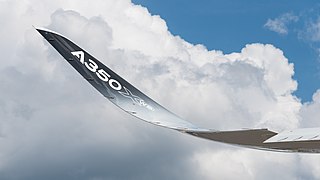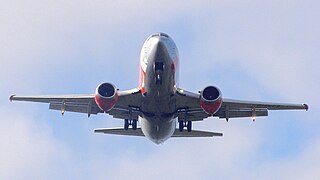
The Boeing 767 is an American wide-body aircraft developed and manufactured by Boeing Commercial Airplanes. The aircraft was launched as the 7X7 program on July 14, 1978, the prototype first flew on September 26, 1981, and it was certified on July 30, 1982. The initial 767-200 variant entered service on September 8, 1982, with United Airlines, and the extended-range 767-200ER in 1984. It was stretched into the 767-300 in October 1986, followed by the 767-300ER in 1988, the most popular variant. The 767-300F, a production freighter version, debuted in October 1995. It was stretched again into the 767-400ER from September 2000.

The Boeing 777, commonly referred to as the Triple Seven, is an American long-range wide-body airliner developed and manufactured by Boeing Commercial Airplanes. The 777 is the world's largest twinjet and the most-built wide-body airliner. The jetliner was designed to bridge the gap between Boeing's other wide body airplanes, the twin-engined 767 and quad-engined 747, and to replace aging DC-10 and L-1011 trijets. Developed in consultation with eight major airlines, the 777 program was launched in October 1990, with an order from United Airlines. The prototype was rolled out in April 1994, and first flew in June. The 777 entered service with the launch operator United Airlines in June 1995. Longer-range variants were launched in 2000, and first delivered in 2004.

The Boeing 757 is an American narrow-body airliner designed and built by Boeing Commercial Airplanes. The then-named 7N7, a twinjet successor for the trijet 727, received its first orders in August 1978. The prototype completed its maiden flight on February 19, 1982, and it was FAA certified on December 21, 1982. Eastern Air Lines placed the initial 757-200 variant in commercial service on January 1, 1983. A package freighter (PF) variant entered service in September 1987 and a combi model in September 1988. The stretched 757-300 was launched in September 1996 and began service in March 1999. After 1,050 had been built for 54 customers, production ended in October 2004, while Boeing offered the largest 737 NG variants as a successor.

Microsoft Flight Simulator is a series of flight simulator programs for MS-DOS, Classic Mac OS and Microsoft Windows operating systems. It was an early product in the Microsoft application portfolio and differed significantly from Microsoft's other software, which was largely business-oriented. As of November 2022, Microsoft Flight Simulator is the longest-running software product line for Microsoft, predating Windows by three years. Microsoft Flight Simulator is one of the longest-running PC video game series of all time.

Wingtip devices are intended to improve the efficiency of fixed-wing aircraft by reducing drag. Although there are several types of wing tip devices which function in different manners, their intended effect is always to reduce an aircraft's drag. Wingtip devices can also improve aircraft handling characteristics and enhance safety for following aircraft. Such devices increase the effective aspect ratio of a wing without greatly increasing the wingspan. Extending the span would lower lift-induced drag, but would increase parasitic drag and would require boosting the strength and weight of the wing. At some point, there is no net benefit from further increased span. There may also be operational considerations that limit the allowable wingspan.

ETOPS is an acronym for Extended-range Twin-engine Operations Performance Standards—a special part of flight rules for one-engine-inoperative flight conditions. The International Civil Aviation Organization (ICAO) coined the acronym for twin-engine aircraft operation in airspace further than one hour from a diversion airport at the one-engine-inoperative cruise speed, over water or remote lands, or on routes previously restricted to three- and four-engine aircraft.

The General Electric GE90 is a family of high-bypass turbofan aircraft engines built by GE Aviation for the Boeing 777, with thrust ratings from 81,000 to 115,000 pounds-force. It entered service with British Airways in November 1995. It is one of three options for the 777-200, -200ER, and -300 versions, and the exclusive engine of the -200LR, -300ER, and 777F. It was the largest jet engine, until being surpassed in January 2020 by its successor, the 110,000 lbf (490 kN) GE9X, which has a 6-inch (15 cm) larger diameter fan. However, the GE90-115B, the most recent variant, is rated for a higher thrust than the GE9X.
Transaero, officially OJSC Transaero Airlines was a Russian airline that operated scheduled and charter flights to over 150 domestic and international destinations. Transaero's main hubs were Moscow Vnukovo Airport and Saint Petersburg Airport, with further bases throughout Russia. For much of its history the head office was at Domodedovo International Airport, and towards the end its head office was in Saint Petersburg.

Boeing Commercial Airplanes (BCA) is a division of The Boeing Company. It designs, assembles, markets, and sells jet airliners and business jets, and also provides product-related maintenance and training to customers worldwide. BCA operates out of its division headquarters in Renton, Washington, and has more than a dozen engineering, manufacturing, and assembly facilities located throughout the United States and internationally. It includes the assets of the Douglas Aircraft division of the former McDonnell Douglas Corporation, which merged with Boeing in 1997. As of the end of 2021, BCA employed about 35,926 people.

In 1997 British Airways (BA) adopted a new livery. One part of this was a newly stylised version of the British Airways "Speedbird" logo, the "Speedmarque", but the major change was the introduction of tail-fin art. Also known as the Utopia, World Tails and world image tailfins, they used art and designs from international artists and other sources to represent communities in countries served by BA's route network. The signature of the artist was carried near the design on the tail.

A twinjet or twin-engine jet is a jet aircraft powered by two engines. A twinjet is able to fly well enough to land with a single working engine, making it safer than a single-engine aircraft in the event of failure of an engine. Fuel efficiency of a twinjet is better than that of aircraft with more engines. These considerations have led to the widespread use of aircraft of all types with twin engines, including airliners, fixed-wing military aircraft, and others.
Microsoft Flight Simulator began as a set of articles on computer graphics, written by Bruce Artwick throughout 1976, about flight simulation using 3-D graphics. When the editor of the magazine told Artwick that subscribers were interested in purchasing such a program, Artwick founded Sublogic Corporation to commercialize his ideas. At first the new company sold flight simulators through mail order, but that changed in January 1979 with the release of Flight Simulator (FS) for the Apple II. They soon followed this up with versions for other systems and from there it evolved into a long-running series of computer flight simulators.

Microsoft Flight Simulator X is a 2006 flight simulation video game originally developed by Aces Game Studio and published by Microsoft Game Studios for Microsoft Windows. It is the sequel to Microsoft Flight Simulator 2004 and the tenth installment of the Microsoft Flight Simulator series, which was first released in 1982. It is built on an upgraded graphics rendering engine, showcasing DirectX 10 features in Windows Vista and was marketed by Microsoft as the most important technological milestone in the series at the time. FSX is the first version in the series to be released on DVD media.
X-Plane Airliner is a game for the iOS and webOS developed and published by Laminar Research.

The United Airlines fleet consists of 944 mainline aircraft, giving it the third largest commercial airline fleet in the world. It primarily operates a mix of Airbus and Boeing narrowbody and all Boeing widebody aircraft.

First class is a travel class on some passenger airliners intended to be more luxurious than business class, premium economy, and economy class. Originally all planes offered only one class of service, with a second class appearing first in 1955 when TWA introduced two different types of service on its Super Constellations.
Ethiopian Airlines operates a fleet of Airbus A350, Boeing 737, Boeing 767, Boeing 777, Boeing 787 and Bombardier Dash Q-400 aircraft.

This is the history of American aerospace manufacturing company Boeing.













